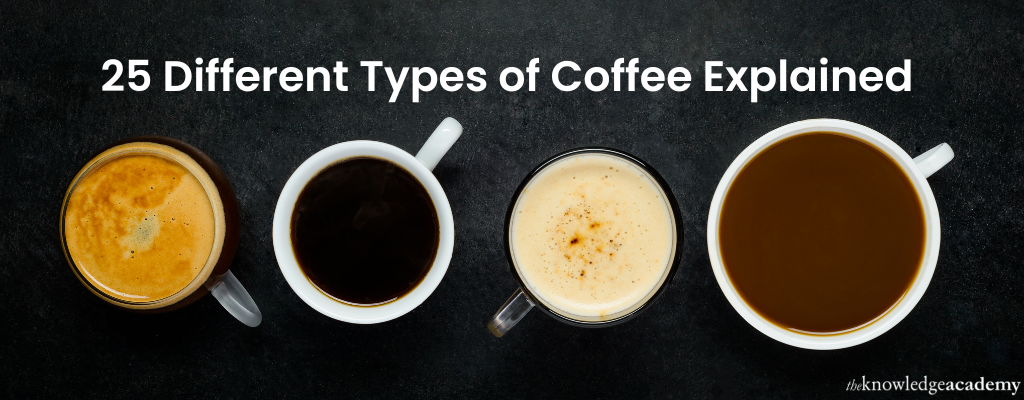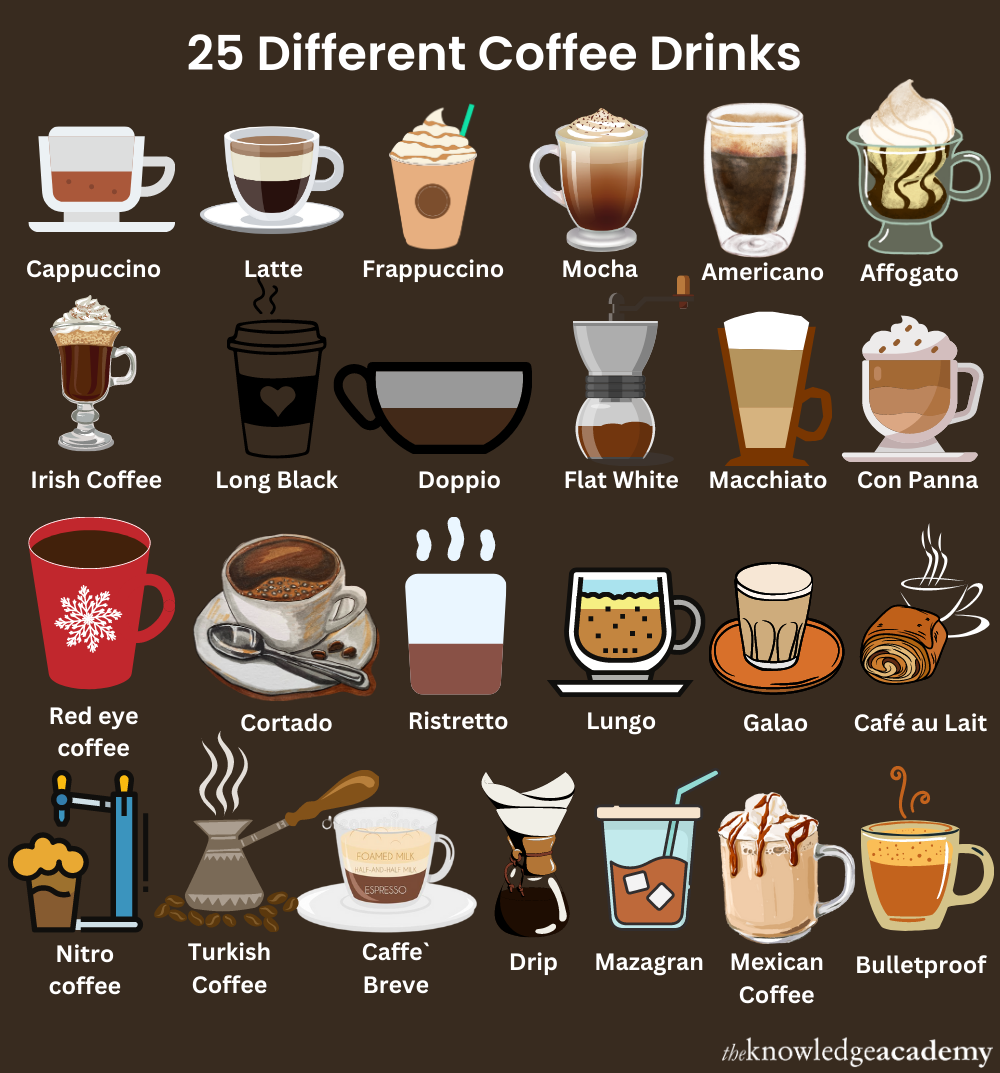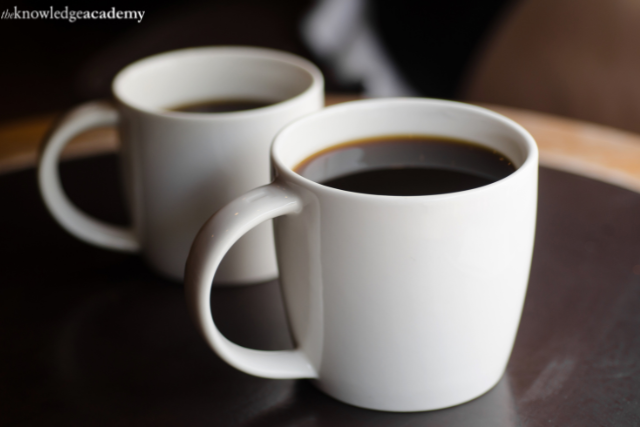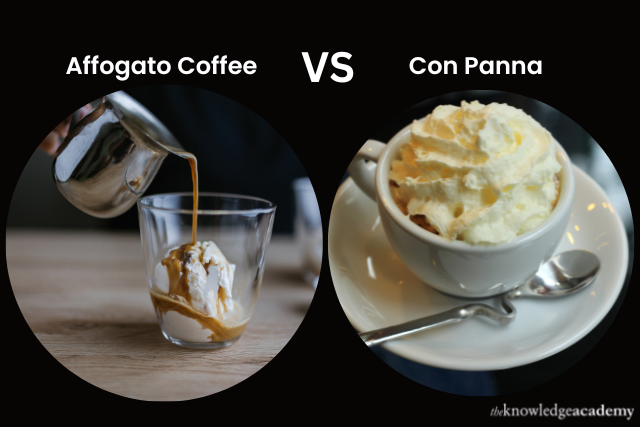We may not have the course you’re looking for. If you enquire or give us a call on 01344203999 and speak to our training experts, we may still be able to help with your training requirements.
Training Outcomes Within Your Budget!
We ensure quality, budget-alignment, and timely delivery by our expert instructors.

With its first cultivation during the middle of the 15th century, Coffee has expanded its wings around every corner of the world. It has gradually taken place in everyone's hearts. Most of us need that one 'morning Coffee' to kick-start our day.
According to Statista, 166.63 million 60-kilogram bags of Coffee were consumed worldwide in 2020-21. It is placed as one of the most widely consumed beverages around the globe.
However, have you ever wondered what's so special about your favourite drink? What can be some other Coffee types? What is that special ingredient that makes it your top priority?
Well, then, let's explore everything about different Types of Coffee drinks in this blog.
Table of Contents
1) Coffee and its origin
2) Types of Coffee beans
a) Arabica
b) Robusta
3) Different Types of Coffee drinks: Explained
4) Conclusion
If you want to start your career as a Coffee professional or learn for personal use, join our Basic Barista Course today!
Coffee and its origin
The origins of Coffee are often debated. However, it is said to have its roots in Middle East Asia, specifically Ethiopia (during the mid-15th century). According to a popular legend, a goat herder, Kaldi, found that chewing on a particular berry filled his goats with energy and kept them up at night. Thus, it was from the Ethiopian land it took on to become the world's finest beverage.
Further, it was introduced into European countries during the 16th – 17th centuries. Although, until the end of the 17th century, the drink faced both rejection and approval for religious, political, and medical concerns. Thus, the African-Arabian land became the sole producer and exporter of this newly introduced beverage.
In the 20th century, with the onset of colonisation, coffee's introduction to third-world countries spread its production like wildfire. The Indian subcontinent, with Brazil, Java, and African countries, started serving the British colonies.
Eventually, with the emergence of Coffee houses worldwide, it became a daily requirement for commoners and the elites. According to GlobeNewswire, the Coffee market is valued at £101.51 billion worldwide. It is estimated to go as high as £157.55 billion by 2027.
Types of Coffee beans
We all love drinking Coffee. We go to a Coffee shop and order our favourite flavour every time. But the question is, why does it taste different if it is grown on the same plant?
Well, to solve this puzzle, take a quick look at some Types of Coffee beans:
Arabica |
Robusta |
|
Arabica is the most popular and widely used Coffee bean. |
Also known as “the outcast,” robusta is entirely different from arabica. |
|
It has a complex flavour: ranging from floral and sweet to dark chocolate, which makes it the favourite of most consumers. |
Compared to arabica, robusta has a bitter flavour with acidic and grainy nature. |
|
Arabica is typically used for black Coffee and has a sweeter taste. |
It makes a perfect fit for espresso drinks and instant Coffee mixes. |
|
Though it is a famous Coffee bean, it does not contain as much caffeine as robusta. |
Robusta is a cheaper option for Coffee enthusiasts with high caffeine content. |
|
Arabica is grown in high-altitude regions and usually grows at a low pace. |
Robusta grows in lower-altitude areas and at two times faster rate than arabica. |
Join our renowned Train the Trainer course and gain the expertise you need to inspire and educate others effectively.
Different Types of Coffee drinks: Explained
While standing in line at a Coffee shop, customers often struggle to choose the right flavour. With numerous Types of Coffee flavours handy, such a struggle is apparent! While multiple Types of Coffee are available, the customers end up ordering the same-old flavours they are used to drinking.
End the struggle now! You need not refrain from discovering new flavours of Coffee. We have got you covered.
Below are 25 different Types of Coffee and their characteristics that will make you fall in love with this beverage.

Cappuccino
Even if one is not a Coffee fan, all must be aware of this famous beverage. Cappuccino is an espresso-based drink that comes from an Austrian drink called Kapuziner. It is touted as the ‘ideal morning Coffee,’ prepared with steamed milk foam or micro foam.
There are different ways to prepare a Cappuccino. However, generally, it is prepared by pouring equal amounts of steamed milk and foam into one-third of the espresso. Thus, it is more intense than most of its counterparts.
Latte
Latte derives its roots from the Italian land. The word Latte means ‘milk Coffee’ in Italy. This type of Coffee is a much creamier version, said to have served the American tourists in Italy who thought cappuccino was too strong for their palate.
Although, a latte is made with espresso and a high quantity of steamed milk. It is also served as an iced latte in most parts of the world.
Frappuccino
Another popularly known drink is Frappuccino. Although its origin is an accidental one, today, Starbucks owns the trademarks for Frappuccino.
It is an espresso-based drink consisting of a crème base blended with iced Coffee. However, other alternatives are also available that are caffeine free.
While Frappuccino is a blended type of Coffee, frappes are shaken or whisked. The terms are often used interchangeably.
Mocha
Some believe that Moka or Mocha is a type of arabica grown in Yemen. On the other hand, the drink is considered to be popularised by an Italian Coffee house named Caffe al Bicerin.
The mocha Coffee bean is famous for having a green and yellow tint compared to the other brown-coloured beans. It is a chocolate-flavoured warm beverage made with layers of espresso, milk and chocolate.
Americano
Americano is a strong Italian espresso drink. Its history dates back to World War II when American soldiers were stationed in Italy. They wanted something resembling the black Coffee that they used to drink. This adaptation was received to such an extent that it got its name as ‘Americano.’
This type of Coffee contains an espresso shot diluted in hot water. It Gives a similar strength too, but a different flavour from traditionally brewed ones.
Irish Coffee
Irish Coffee is a perfect fit for a wintry night. It was first brewed in 1943 by Joe Sheridan, an airport chef who came up with the drink on a chilly winter night to comfort misplaced passengers.
Although a beverage, Irish Coffee is prepared as a cocktail containing: Coffee, whiskey, sugar, and cream. Remember, while making the cocktail, only heat the Coffee and pour other ingredients into it.
It is a go-to drink for everyone who wants to chill at home and be comfortable.
Long Black
Sharing its similarities with Americano, long black Coffee is also a simple drink to make. You only need two ingredients: espresso and water. A shot of espresso is added to a cup of hot water to prepare a long black Coffee. Unlike Americano, where you pour hot water into a shot of espresso.
This simple difference in preparation changes the flavour as well as the intensity of caffeine in the drink. As a result, the long black is a creamier and less diluted version of Americano.
Doppio
Doppio means ‘double’ in Italian. A doppio usually includes two shots of expresso rather than a single. But people often confuse it with serving even three espressos.
Commonly, the preparation of a doppio does not include any flavour, cream, sugar, or even milk. It is made in the same manner as an ideal Caffe, i.e., with equal water and espresso content. Then why should you buy a doppio? Well, if one shot isn't enough for you to get going, add an extra pep with a double shot (doppio).

Flat White
The heated debates between Australia and New Zealand to stake the claims of Flat White have made it a well-known beverage in the Western world. Despite its disputed origins, a flat white is served similarly worldwide.
It relates to the Latte since it is an espresso-based drink made with steamed milk and a thin foam layer. However, it has a much higher proportion of espresso than milk.
Macchiato
A macchiato is essentially an espresso-based drink that means stained or spotted in Italian. This type of Coffee is similar to both, Cappuccino and Doppio. However, the difference lies in the small amount of milk foam on its top that mellows its intensity.
Apart from the espresso-based Macchiato, the drink also has other versions. There exists a latte macchiato that is the complete opposite of the espresso. Here, a shot of espresso is stained with steamed milk.
Red Eye
An extremely strong drink, the Red Eye got its name after a red-eye flight flying predominantly at night, leaving the passengers tired and exhausted. The red eye is a cup full of hot Coffee with an espresso shot. It is the perfect drink to rid of your morning laziness.
Although the red eye has a high caffeine intensity, other stronger versions of the drink also exist. For example, the black eye uses two espresso shots with its drip Coffee.
Cortado
Since the milk is used to cut back the espresso's acidity; thus, the name cortado, which in Spanish means ‘cortar or to cut.’ It was first seen in Spain's Basque County, where cortado was given its name.
The milk blends smoothly into the espresso without forming any layers. It provides a space for the flavours to enhance. Thus, a cortado becomes a fine balance of espresso and steamed milk.
Ristretto
Ristretto is an Italian word for restricted. It is fundamentally an espresso shot, however, with a subtle difference in flavour from the standardised shots. The drink uses a little hot water, usually 15-20 millilitres. Thus, it has a sweeter and brighter flavour compared to the bitter taste of traditional espresso or a doppio.
Lungo
As opposed to the Ristretto, a Lungo is bitter and smokier. It is also called a long-pull espresso, i.e., the longer you pull, the more caffeine will be there. In simple terms, it is a standardised amount of espresso with more amount of water than in a Ristretto.
Lungo is slightly more caffeinated than other espresso-based drinks. It is because the prolonged water draws marginally more caffeine from the beans. Thus, it takes up to one minute to pull, while a single espresso shot usually takes 28 to 30 seconds.
Galao
While talking of several Types of Coffee, next in the line is Galao. Coming from Portugal, the drink closely relates to Cappuccino and the Latte. Galao is a Portuguese version of Latte. The only difference between it and the other two drinks is that it has twice as much foamed milk.
Traditionally, to make a Galao, a blend of Robusta and Arabica is used. Robusta beans and hot milk are frothed with a whisk or frother in a pan. Further, you may also add sugar and honey according to your palate. This will provide you with a thicker, creamier and less bitter flavour.
Affogato
Affogato is an overwhelming combination of a scoop of vanilla ice cream and hot espresso. If you have a sweet tooth, this drink will be the icing on the cake! However, some people categorise it as a beverage; others might call it a dessert. But the tussle does not affect this heaven-made combination.
You can make an Affogato with any espresso topped with chocolate or caramel drizzle. You can also serve the drink with a brownie and enjoy your drink/dessert!

Con Panna
Italian word for cream, Con Panna is also an espresso-based drink served with a whirl of whipped cream on top. Like Mocha, Affogato, and other chocolate-based espresso, Con Panna is a dessert-like, sweet beverage. It is confused with Viennese Coffee. Some people might even associate it with Turkish Heritage; however, its origin is often disputed.
To brew a Con Panna, take a shot of espresso into a cup and add whipped cream on its top. It best suits people who like sweet and strong flavours simultaneously.
Café au Lait
If you like your drink creamy, smooth, and less intense, Café au Lait is the one for you! This French beverage is traditionally prepared with French-pressed and steamed milk.
It contains equal parts of brewed Coffee and hot milk. Café au Lait is smooth and balanced compared to Latte, which is also prepared in the same manner but has high caffeine content.
Some people may not like it for its bland flavour, but you may spice it up with flavoured beans or a pinch of cinnamon powder on top.
Nitro
Nitro is a new addition to the world of Coffee, inspired by a technique used by people who brewed beers at home in the 2010s.
Nitrogen is infused into a cold brew through a pressure valve. Since nitrogen has neither a colour nor a smell, the gas rids the Coffee of all oxygen and stops its flavour from decomposing. As a result, the brew gets a silky texture with numerous tiny bubbles.
Nitro is compared with cold brew. However, it has low acidic content. The drink became popular amongst the third-wave Coffee drinks.
Turkish Coffee
Turkish Coffee has been recognised for its Intangible Cultural Heritage. It is believed to serve as a symbol of friendship and hospitality. The drink is prepared in a unique metal pot with a long handle called a cezve. The beverage is left to boil in the cezve over hot sand till it is just about to spill. It is then served in a standard cup.
Turkish Coffee is generally unfiltered. Thus, it has a good amount of caffeine.
Caffe` Breve
Caffe` Breve has an American origin, inspired by Italian Latte. Caffe Breve is made with a shot of espresso, steamed half-and-half, and a layer of milk foam. This drink has more foam than the average milk-based espresso. Therefore, it has a rich and creamy flavour and is believed to be a dessert Coffee.
Drip
A drip or brewed is less caffeinated than espresso. To make a drip, you need two spoons of ground Coffee for six ounces of water. However, the amounts could be adjusted according to your needs for caffeine.
Drip or brewed is also a Coffeemaker that is a common sight in American kitchens.
Mazagran
This drink might interest you if you like to experiment. A mazagran is a cross between iced tea, Coffee, and rum. It is typically made with espresso, lemon, sugar, and sometimes rum.
Mexican Coffee
With a North American origin, Mexican Coffee is there to give you booze for the day. Take one ounce of Coffee, one-half ounce of tequila, and five ounces of hot Coffee to make this smooth and creamy drink.
You may also add cinnamon powder to your Coffee before brewing if you like it strong.
Bulletproof
Bulletproof has an interesting origin to it. The American computing axec, Dave Asprey, was served a tea mixed with yak butter while he was on a trek. In 2010 he came up with an unusual combination of Coffee and grass-fed butter.
This beverage is made by blending one cup of brewed Coffee with 1 to 2 tablespoons of oil and another tablespoon of unsalted butter till it turns creamy.
Yes, it is high in fats and calories; however, bulletproof can be a low-carb meal replacement for breakfast.
Conclusion
Through this long list of distinct Types of Coffee, we have seen that it is more than just a beverage. With a slight difference in the amounts of water, espresso, cream, and other ingredients, Coffee's flavor, caffeine content, and intensity could be changed completely. As coffee culture reaches every corner of the world, people are not only interested in discovering new flavors and techniques but also exploring How To Make Hazelnut Coffee, adding a delightful twist to their coffee experience.
If you want to learn and excel in popular fields like Phone Repair, Coffee Brewing, Floristry, and many more, try our Industry Training course today!
Frequently Asked Questions
Upcoming Business Skills Resources Batches & Dates
Date
 Basic Barista Course
Basic Barista Course
Fri 25th Oct 2024
Fri 21st Feb 2025
Fri 25th Apr 2025
Fri 20th Jun 2025
Fri 29th Aug 2025
Fri 31st Oct 2025
Fri 19th Dec 2025







 Top Rated Course
Top Rated Course




 If you wish to make any changes to your course, please
If you wish to make any changes to your course, please


